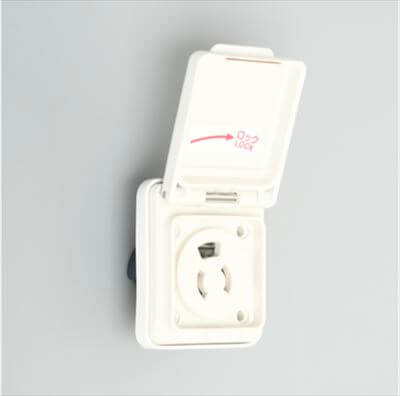What Is an Outlet Box?

An outlet box is a plug socket for supplying alternating current.
Outlet boxes come in a variety of voltage types and shapes.
AC refers to alternating current, which is an electric current that periodically switches between positive and reverse current flow. Its counterpart is DC (direct current).
Uses of AC Outlet Boxes
Outlet boxes are used in a wide range of applications, from home use to industrial use. Specific uses are as follows:
- For supplying power to household appliances
- For supplying power to submersible pumps for factory drainage
- For supplying power to submersible pumps for draining cutting points in construction work
- For supplying electric power to AC adapters for personal computers
- For supplying electric power to air conditioners
Electricity is supplied to a wide range of indoor equipment, from office automation equipment to home-use game consoles. It is also used outdoors for applications, such as submersible pumps.
Principle of AC Outlet Boxes
An outlet box is composed of a body, mounting bracket, blade receiving spring, wiring connection terminal, and decorative plate.
1. Body
The body is the main body of the outlet and supports each component. It is mainly composed of synthetic resin, an insulating material. It supports the charging part while covering and protecting it with insulating material, and has the role of accepting the plug by means of the insertion hole.
2. Mounting Bracket
The mounting bracket is the metal part used to attach the body to the wall. In most cases, the material is a robust metal such as steel. The mounting bracket is characterized by the body’s solid fit and by the openings in various places for screwing it into the wall.
3. Blade Receiving Spring
The blade receiving spring is a spring that accepts the metal part of the outlet plug. It is made of metal, a conductive material, and is integrated with the wiring connection terminal.
It is a part that electrically conducts the outlet plug and the wiring connection terminal. The spring part fits into the hole in the plug to prevent the plug from falling out.
4. Wiring Connection Terminal
The wiring connection terminal is used to connect the wiring to the outlet. For 100 V outlets for home use, plug-in terminals are often used. In anticipation of cross-wiring work, two or more plug holes of the same potential are usually drilled.
5. Decorative Panel
A decorative panel is a panel used to hide the mounting hardware and wiring portion of an outlet. It is often only clipped on by nails and can be easily removed by hand.
Types of AC Outlet Boxes
There are numerous types of Outlet Boxes, including those for three-phase and 200 VAC. Even the most commonly seen A-type 100 VAC Outlet Boxes come in a wide range of types, as shown below.
1. Recessed Type Outlet
This outlet box is embedded in the wall surface of a home or office. It is connected to a wall board with screws and embedded. Double outlets with two ports are commonly used.
2. Drip-Proof Outlet
An outlet box with a plate attached to prevent water droplets from entering the outlet. This type of outlet is used in locations where water droplets may splash. Generally used indoors in bathroom changing rooms, but may also be installed outdoors.
3. Rainproof Outlet
This is an outlet box with the outlet facing down. Rainproof outlets are used for outlets installed on the exterior walls of buildings and outdoors. Since the mouth faces down, many products use a hook-and-loop type receptacle that is caught when twisted.
4. Pop-Up Type Outlet
This is an outlet that is usually stored on the floor and pops up when in use. It is also called an up-con. Often used in offices, meeting places, etc.
Other Information on Outlet Boxes
Origin of the Word “Outlet”
The word “outlet” is said to have originated from “concentric plug.” The name “outlet” is derived from the fact that the shape of the imported outlet was concentric (concentric circle, coaxial).